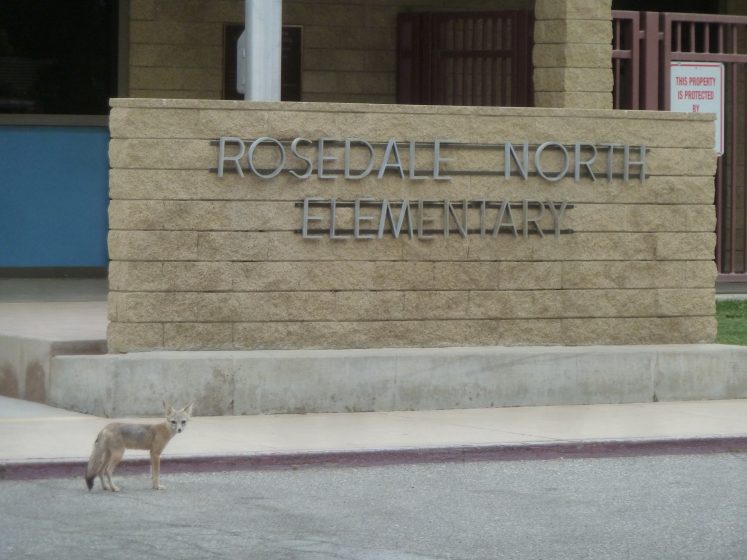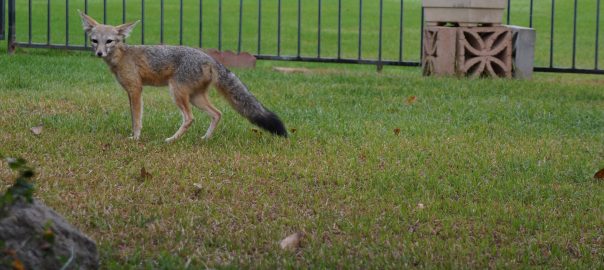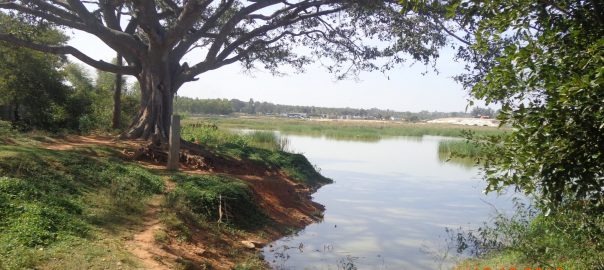If I were to ask you where I could find a healthy population of the endangered San Joaquin Kit Fox, you might be forgiven for not immediately saying, “Why, Bakersfield, of course!” Bakersfield? The Oil Capital of California? Yes, the very same!
Unlikely as it seems, this oil-town-turned-city sprawling at the southern end of the Central Valley—butt of bad jokes and dark fiction in Hollywood, and home to nearly half a million people—has also become a refuge for a growing population of San Joaquin Kit Foxes.
This subspecies of the Kit Fox, found throughout the deserts of the American Southwest, is named after its native San Joaquin Valley home, which it has mostly lost to farming and urban development over the last century. Its population declined so drastically that it became one of the first species to be officially listed as Endangered by the federal government in 1967. Its cousin, the Southern California Kit Fox went extinct in 1903, and the San Joaquin Kit Fox has been pushed to the outer margins as humans have transformed the Central Valley into the agricultural engine of California. This little canid has seemed like a permanent member of the endangered species list through nearly half a century.

In addition to losing habitat, the subspecies also suffered from changes in populations of other carnivores in California: the big bad Wolf was extirpated from the region, allowing the smaller Coyote and Bobcat populations to grow; this has been bad news for the Kit Fox, as both these mid-sized predators prey on the smaller Kit Fox; the introduction of non-native Red Foxes has also meant greater competition for already diminishing habitat. The case of the San Joaquin Kit Fox has seemed like a classic case of a species being sucked into an extinction vortex by the forces of direct and indirect human impacts. But surely, the most visibly extreme way humans destroy native habitats is by building cities. So, how does a little kit fox manage to live and, indeed, thrive in the middle of this urban sprawl?
By the late 1990s, wildlife biologist Brian Cypher of the Endangered Species Recovery Program at California State University, Stanislaus, knew there were a few foxes in Bakersfield, stragglers he thought, that had somehow managed not to die amid development. Watching them more closely, he started noticing that the same individuals (with visible markers identifying them) were apparently holding down home ranges for long periods. He started noticing pups, which meant these individuals were also reproducing. Were they establishing themselves in the city? Thus began Cypher’s long-term research on these urban foxes, which continues to surprise the veteran conservationist.
Just like the humans who build cities, the kit foxes, it turns out, find urban habitats to be safer and more nourishing than the surrounding countryside. The lack of large urban forest patches or wooded areas means that unlike their Chicago cousins, Bakersfield coyotes avoid the city; so do bobcats. The city also provides an endless smorgasbord for a small omnivorous predator, ranging from junk food in garbage that people toss out to more nutritious dog and cat food intentionally supplied by those who like having kit foxes around in their neighborhoods.

As it turns out, the big city is not such a bad place for an endangered kit fox to raise a family, or several. And they do just that, in abundance. Cypher’s research indicates that while only one in ten of the pups born in the countryside survive past the first year of life, over half of the urban pups survive in Bakersfield. This drop in first-year mortality is one reason why the kit foxes are thriving in the city, with population densities much higher than outside it. While a single pair may occupy two square miles of countryside, in Bakersfield, Cypher and his team have identified (using camera traps) more than 30 individuals living on the local California State University campus alone. Across the city, he estimates there is a population of 400-500 kit foxes that is growing, making Bakersfield home to their 3rd largest remaining population.
Carnivores generally don’t fare well at high densities. Island Foxes stuck in high densities on the Channel Islands, Cypher tells me, “look always torn up, like they are always fighting all the time”. Mainland foxes prefer to keep their distance from each other, maintaining territories through scent marking, and avoiding direct confrontation whenever possible. One might, therefore, “expect more aggression” among Bakersfield’s kit foxes. “But that is not the case here”, says Cypher. The urban kit foxes turn out to be “quite docile, and not as fiercely territorial or aggressive” toward each other. Instead, surprisingly, they seem to be engaged in more cooperative behaviors, especially when it comes to raising pups.
Kit Foxes born in the countryside tend to disperse from their parents to find their own territories within a year or two. While an older pup may linger past the first year and help raise next year’s brood, helpers at the den are rare. In the city, however, Cypher finds a lot more helpers, possibly because there is a steady supply of food in a saturated real estate market with few open territories for young foxes to take over. Why not stick around at home, then, and help raise younger siblings? However, urban kit foxes seem to be going beyond this increase in sociality, which is predicted by mathematical models of social behavior. Cypher and his students have documented at least two cases where two females shared a single den, seemingly became pregnant at the same time, and successfully raised their respective litters together in the same den. This level of cooperation is unprecedented in our knowledge of the natural history of Kit Foxes.

In collaboration with geneticists from the Smithsonian Institution, Cypher’s team has discovered that the urban population of kit foxes shows high genetic variation, at levels that may surprise conservation biologists. There is some connectivity of habitat near the eastern edge of town, closer to the foothills. Bakersfield kit foxes, however, prefer to remain in town, and even exhibit some unique alleles, i.e., genetic mutations not found elsewhere, which may play some role in explaining the novel traits seen in this urban population.
There is a different downside to the higher density of foxes: the growing incidence of mange over the past three years. Caused by parasitic mites, this skin disease can, if untreated, eventually kill kit foxes through secondary infection, hypothermia from loss of fur, dehydration, and starvation. Cypher is not sure where the kit foxes are getting infected but suspects the mites may be coming from contact with domestic dogs. “It is unlikely to be coyotes infecting foxes,” he says, because “if a coyote encounters a kit fox, the fox ends up dead!” Domestic dogs are often protected from mange through monthly application of tick and flea prevention medication. Researchers from UC Davis are collaborating with Cypher to determine if the mites on mangy kit foxes are genetically similar to ones found in dogs; if so, the infection may be treatable using similar medication. They plan to test whether over-the-counter mange-preventive collars may also work to protect the kit foxes.
Another potential threat is exposure to anticoagulant rodenticides in the city: accidental consumption has been associated with mange in Bobcats in California. Cypher and colleagues have documented worrisome levels of these chemicals in urban kit foxes, with the anticoagulant rodenticides implicated in at least several known deaths. Whether they also make kit foxes more vulnerable to mange remains to be seen. The recent ban on second generation anticoagulant rodenticides may go some way in reducing this risk of urban life for the kit fox.
On the whole, though, the kit foxes continue to thrive in the urban matrix, even serving as vanguards for new urban development. The threat of coyotes and bobcats keeps kit foxes away from farmland, according to Cypher, “except when the land is allowed to go fallow” resulting in growth of shrubs that provide some cover. Such fallow land at the edge of the city is often a precursor to urbanization, but the kit foxes “don’t seem to get pushed out by development, except in really high-density residential areas. School campuses, golf courses, even commercial areas—anything not residential seems to have foxes in them”, says Cypher. They manage to find nooks and crannies within the sprawl to settle in, so that, counterintuitively, “as development grows, so does the fox population!”
Bakersfield’s kit foxes also thrive because people have grown from merely tolerating them to appreciating their presence in the city. Cypher is applying his team’s research to reconcile urban development with the conservation of this endangered native species by advocating for more thoughtful design of urban landscapes. It is possible to develop the city for humans in ways that also provide the necessities of life for an urban kit fox family, and indeed other wildlife. If the domestic dog is our oldest friend, the San Joaquin Kit Fox may yet be our newest friend, giving us hope of surviving the current extinction crisis with at least some of the native wildlife and wild landscapes folded into our brave new, human-built world.
Madhusudan Katti
Raleigh












2 Comments
Join our conversation